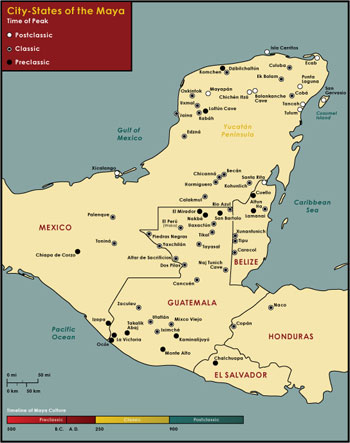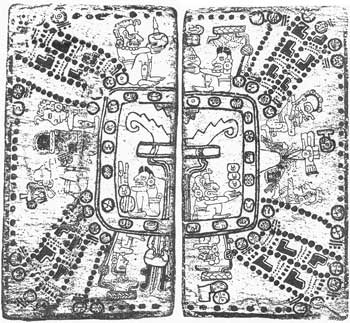The Maya: Ancient and Modern
Just as scientists today study the Sun, Moon, planets and stars, more than a thousand years ago the ancient Maya watched the heavens.
Maya community members tell us that they have been in Mesoamerica for many thousands of years. Archeologists separate Maya history into different time periods that differentiate important changes in the Maya civilization. The Pre-Classic period began as early as 1800 BCE (Before Common Era). Archeologists find evidence that during this time the Maya began settling in what are now southern Mexico, Guatemala, and parts of Belize, Honduras and El Salvador. During the Classic period, between 300 BCE to 900 CE (Common Era), the Maya built their settlements into great cities and the civilization flourished.

Map of Maya City-States. Image Credit: Chabot Space & Science Center.
These cities were as large as or larger than many cities in Europe at the time. They contained grand, magnificently-decorated buildings. Some of these buildings aligned with celestial objects to mark important times of the year. Each city and its surrounding area formed a small “city-state” that was ruled by an ajaw, or king. When the ruling king died, his son became the next king, creating dynasties of rulers.
At the end of the Classic period, the Maya abandoned their cities in large numbers. Nobody knows for sure why this happened. One theory is that resources became more limited due to a growing population and climate changes.
When the Spanish arrived in the early 1500s, the numbers of Maya people decreased further due to warfare and disease. However, the Maya people survived and continue to practice their traditions to this day.
There are many different Maya groups but they all share a common language heritage. More than 30 Mayan languages developed out of a “proto-Mayan” language around 2000 BCE. For example, Yucatec is spoken in the Yucatan peninsula. Chorti is spoken near Copan in Honduras. Chol is spoken near Palenque in Chiapas.
The Maya developed a writing system that used glyphs to represent a sound, word or syllable. This system is particularly sophisticated when compared to other cultures in the Americas. The Maya also created a unique number system that used a combination of bars and dots to create large numbers. Maya mathematics included the concept of zero. The Maya used this revolutionary concept before the ancient Babylonians and Greeks began thinking of zero as a number.
Written glyphs and numbers were carved into stone buildings and monuments, painted on pottery and murals, and written in books. Professional scribes, called aj dzib, wrote in folded bark-paper books called codices. There were many Maya codices, but only four survived to today. All the others were destroyed by the Spanish in the 16th century. Fortunately, the books that did survive contain a wealth of astronomical and mathematical information.

Image of Tzolkin calendar in Madrid Codex. Image Credit: Randa Marhenke, FAMSI.
From these codices, we know that the Maya were keen observers of the sky. They recorded Venus’ cyclical movements, used math to predict solar and lunar eclipses, and developed an intricate calendar system. This information has allowed the Maya to shape their daily activities and broader culture, determining when to plant crops, when to conduct rituals, when to celebrate.
Maya rulers used astronomical information to reinforce their elite status and maintain power. Kings would associate themselves with particular celestial bodies, such as the Sun, Moon or planets. This would establish their connection to the Universe and support their right to rule. For example, a king who portrayed himself as the Sun may be crowned on one of the two days of the year when the Sun passed directly overhead. Such symbolism reinforced peoples’ beliefs that the king was in tune with divine order.
When the kingship systems began to crumble at the end of the Classic period, many parts of culture that supported the rulers were abandoned. This included the writing system, the Long Count calendar and astronomical record-keeping. Much of this knowledge was not passed down to the modern Maya. Some aspects of the ancient knowledge survived at the time of Spanish contact. However, great effort was made to ensure that the Maya would abandon this knowledge in favor of Western thought.
It was not until the second half of the 20th century that the four remaining codices were deciphered. When the meaning of the glyphs was decoded, the astronomical, mathematical and literary genius of the ancient Maya civilization was revealed. It has taken decades for this information to finally filter down to modern Maya.
Despite great challenges, the Maya have been able to hold on to knowledge and many ancient practices continue to be passed down through the generations. Traditions relating to religious and agricultural practices have many direct links to the Classic period. In recent times the modern Maya have begun to actively participate in rediscovering their ancient knowledge.

Maya women at San Simon enter GIS data into a computer to tag pottery sherds. (Image credit: Jose Huchim Herrera, INAH)
Today, there are more than six million Maya who live in Mesoamerica, the United States, and throughout the world. Many modern Maya are caught between two worlds, where Western traditions conflict with traditional ways. Traditions such as language, agriculture, and religious beliefs are threatened by non-Maya ideas and ways of living. Despite the many conflicts and threats to the Maya way of life, a tenacious and resilient Maya culture is preserved through customs and language. Just like the Maya community are returning to their past, many other cultures around the world are learning from the Maya culture and their calendars as a way to live in harmony and balance in their lives.
The full richness of the Maya culture continues to be uncovered. More than two thousand archaeological sites are still unexcavated in the Yucatan alone. The modern Maya play an active role in rediscovering their past. They are using modern archaeological techniques to conduct research and restore ancient sites. Many ancient Maya cities are UNESCO World Heritage Sites. They are an important part of our past and present, and belong to all of us.